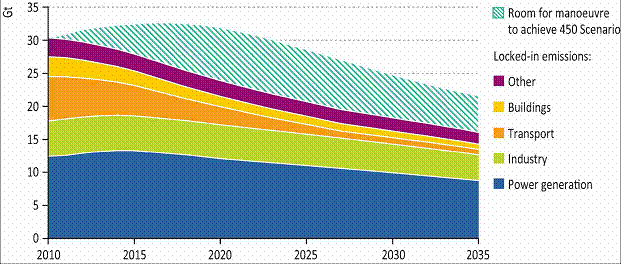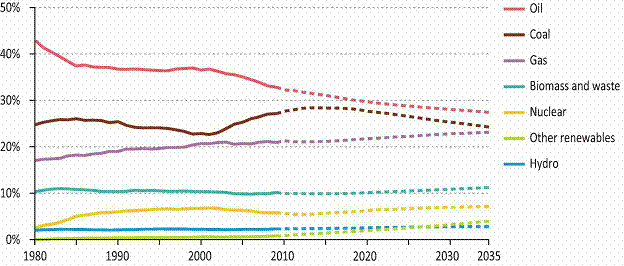In the WEO's central New Policies Scenario, which assumes that recent government commitments are implemented in a cautious manner, primary energy demand increases by one-third between 2010 and 2035, with 90% of the growth in non-OECD economies. China consolidates its position as the world's largest energy consumer: it consumes nearly 70% more energy than the United States by 2035, even though, by then, per capita demand in China is still less than half the level in the United States. The share of fossil fuels in global primary energy consumption falls from around 81% today to 75% in 2035. Renewables increase from 13% of the mix today to 18% in 2035; the growth in renewables is underpinned by subsidies that rise from $64 billion in 2010 to $250 billion in 2035, support that in some cases cannot be taken for granted in this age of fiscal austerity. By contrast, subsidies for fossil fuels amounted to $409 billion in 2010.
Global installed power generation capacity and additions by technology in the New Policies Scenario
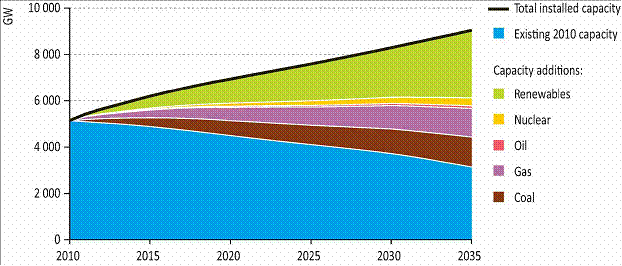
Renewables and nuclear power account for more than half of all the new capacity added worldwide through to 2035
The IEA states that short-term pressures on oil markets are easing with the economic slowdown and the hope that Libya will recover to supply. But the average price of oil remains high, approaching $120/barrel (in year-2010 dollars) in 2035. As a consequence, reliance grows on a small number of producers mainly from the Middle East and North Africa (MENA) which is over 90% of the required growth in world oil output to 2035. If, between 2011 and 2015, investment in the MENA region runs one-third lower than the $100 billion per year required, consumers could face a near-term rise in the oil price to $150/barrel.
The forecast by IEA is that the oil demand rises from 87 million barrels per day (mb/d) in 2010 to 99 mb/d in 2035, with all the net growth coming from the transport sector in emerging economies. The passenger vehicle fleet doubles to almost 1.7 billion in 2035. Alternative technologies, such as hybrid and electric vehicles that use oil more efficiently or not at all, continue to advance but they take time to penetrate markets.
The use of coal, which met almost half of the increase in global energy demand over the last decade, rises 65% by 2035. Prospects for coal are especially sensitive to energy policies, notably in China , which today accounts for almost half of global demand. More efficient power plants and carbon capture and storage (CCS) technology could boost prospects for coal, but the latter still faces significant regulatory, policy and technical barriers that make its deployment uncertain.
Incremental world primary energy demand by fuel, 2000-2010
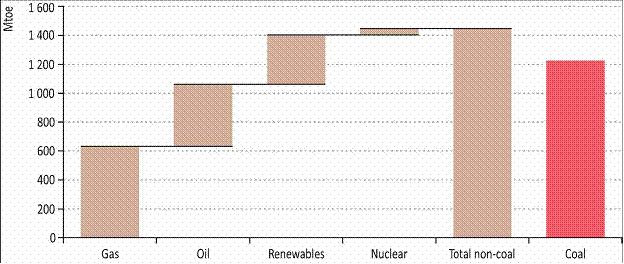
Coal accounted for nearly half of the increase in global energy use over the past decade,with the bulk of the growth coming from the power sector in emerging economies
The catastrophe at Fukushima Daiichi according to the IEA has raised questions about the future role of nuclear power. In the New Policies Scenario, nuclear output rises by over 70% by 2035, only slightly less than projected last year, as most countries with nuclear programmes have reaffirmed their commitment to them. But given the increased uncertainty, that could change. A special Low Nuclear Case examines what would happen if the anticipated contribution of nuclear to future energy supply were to be halved. While providing a boost to renewables, such a slowdown would increase import bills, heighten energy security concerns and make it harder and more expensive to combat climate change.
The future for natural gas is more certain: its share in the energy mix rises and gas use almost catches up with coal consumption, underscoring key findings from a recent WEO Special Report which examined whether the world is entering a "Golden Age of Gas". One country set to benefit from increased demand for gas is Russia , which is the subject of a special in-depth study in WEO-2011. Key challenges for Russia are to finance a new generation of higher-cost oil and gas fields and to improve its energy efficiency. While Russia remains an important supplier to its traditional markets in Europe , a shift in its fossil fuel exports towards China and the Asia-Pacific gathers momentum. If Russia improved its energy efficiency to the levels of comparable OECD countries, it could reduce its primary energy use by almost one-third, an amount similar to the consumption of the United Kingdom . Potential savings of natural gas alone, at 180 bcm, are close to Russia 's net exports in 2010.
Russia remains a cornerstone of the global energy economy
Sources of Russian revenue from fossil fuel export sales
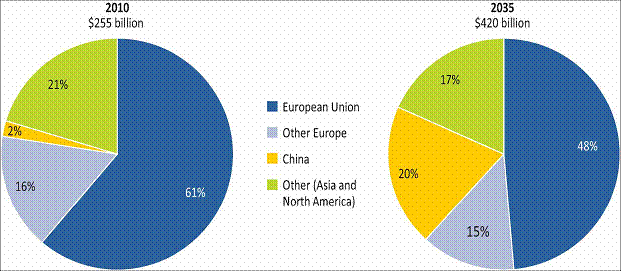
An increasing share of Russian exports go eastwards to Asia ,providing Russia with diversity of markets and revenues
In the New Policies Scenario, cumulative CO2 emissions over the next 25 years amount to three-quarters of the total from the past 110 years, leading to a long-term average temperature rise of 3.5°C. China 's per-capita emissions match the OECD average in 2035. Were the new policies not implemented, we are on an even more dangerous track, to an increase of 6°C.
"As each year passes without clear signals to drive investment in clean energy, the "lock-in" of high-carbon infrastructure is making it harder and more expensive to meet our energy security and climate goals," said Fatih Birol, IEA Chief Economist. The WEO presents a 450 Scenario, which traces an energy path consistent with meeting the globally agreed goal of limiting the temperature rise to 2°C. Four-fifths of the total energy-related CO2 emissions permitted to 2035 in the 450 Scenario are already locked-in by existing capital stock, including power stations, buildings and factories. Without further action by 2017, the energy-related infrastructure then in place would generate all the CO2 emissions allowed in the 450 Scenario up to 2035.
Investment is the essence of energy says the IEA. The graph shows the cumulative investment in energy-supply infrastructure by fuel in the New Policies Scenario, 2011-2035 (in year-2010 dollars)
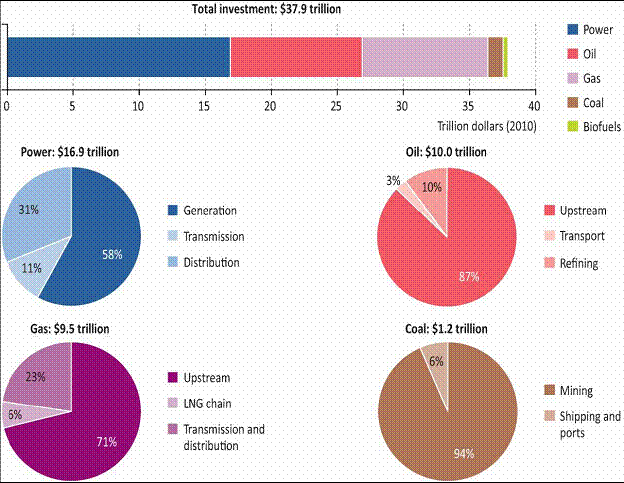
A cumulative investment of $38trillion –almost $1.5 trillion per year –is required in energy-supply investment to 2035, with 45% in the power sector alonesays the IEA report.
Hopefully the leaders of the world's governments, who meet at Durban in December 2011 realise there is no time for pervication or procrstination but hard decisions need to be taken, as renewable energy is our only hope for a sustainable planet.
All graphs courtesy IEA
(Marianne de Nazareth is a fellow with UNEP and UNFCCC) |



